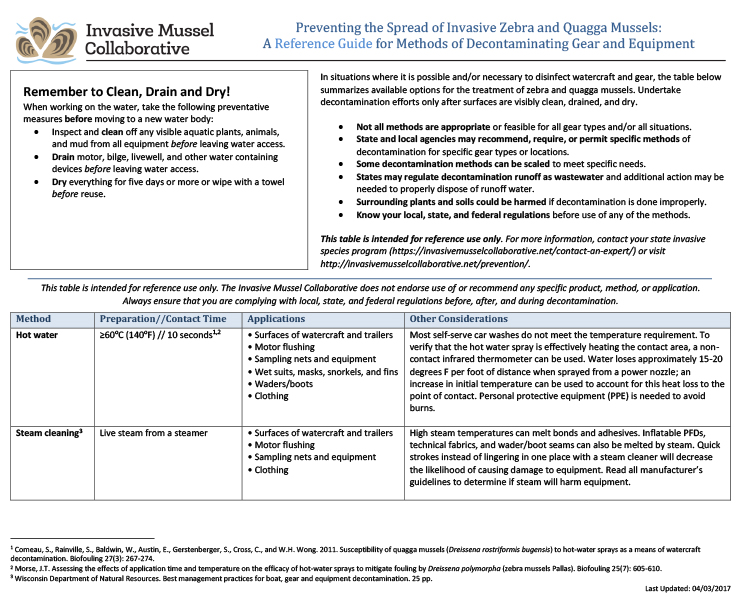Monitoring & Prevention
Managers and Researchers
Scientific researchers and resource managers undertake a variety of activities targeting invasive mussels in the field. While work in the field is integral to containing the spread of mussels and informing future management decisions and activities, prevention is equally as necessary for researchers and managers as it is for any other water body user. Fieldwork and prevention activities must always be compliant with relevant state, provincial, and federal protocols and regulations. Always adhere to any agency recommendations for fieldwork and prevention, as some prevention methods may not be allowed and/or suitable in all areas.
Monitoring Protocols and Programs
Consistent monitoring practices are an integral component of prevention planning for invasive mussels. Early detection of new introductions is key to preventing establishment of new populations and presents the best opportunity for effective treatment and possible eradication.
Monitoring Techniques
The techniques used to monitor a body of water for invasive mussels may shift depending on the monitoring objective and available resources. In instances of routine monitoring, presence/absence methodology may be sufficient, while areas with a suspected introduction of invasive mussels may require more intensive techniques. Per the National Park Service, there are three primary methods of monitoring for new populations of invasive mussels:
“The inability to predict which water body will become infested makes a widespread early detection program critical.”
1. Settling Plates/Samplers
Samplers provide artificial substrate for invasive mussel larvae, or veligers, to settle on. Samplers can be easily constructed from low-cost materials and suspended at various water depths, providing a low-effort sampling option. This method is most viable during invasive mussel spawning periods, which typically begin in early spring and may continue into late fall or early winter, depending on location.
2. Veliger sampling
Plankton tow nets can capture veligers, which must be detected in a lab. Conducting plankton tows is fairly resource-intensive, but may provide the greatest chance for early detection if a population of invasive mussels is too small to be detected otherwise. Like samplers, veliger sampling is only effective during the period of time in which invasive mussels may be spawning.
3. Diver Surveys
Diver surveys may be conducted via snorkel or SCUBA, and are useful in areas where an introduction is suspected. Diver surveys may also be resource-intensive, depending on the area being sampled and the number of personnel required. However, diver surveys can often provide immediate survey results with minimal sampling processing time.
More detailed information about monitoring protocols and sampling methods, including those not mentioned above, is available in our Library, along with other resources for developing early detection programs. If you would like more information about a jurisdiction’s monitoring program or requirements for sampling, please visit our Find an Expert page.
Resources & Publications
Zorinsky Lake Zebra Mussels-Summary Poster
US. Corps of Engineers
Zequanox Application Technique Pilot Study on Lake Erie
Megan M. Weber, Marrone Bio Innovations; Michigan Department of Environmental Quality
Zebra Mussels Invade Ontario Waters
Ontario's Invading Species Awareness Program
Riley T. Lovejoy, Alyssa N. Kandow, Jennifer G. Howeth

